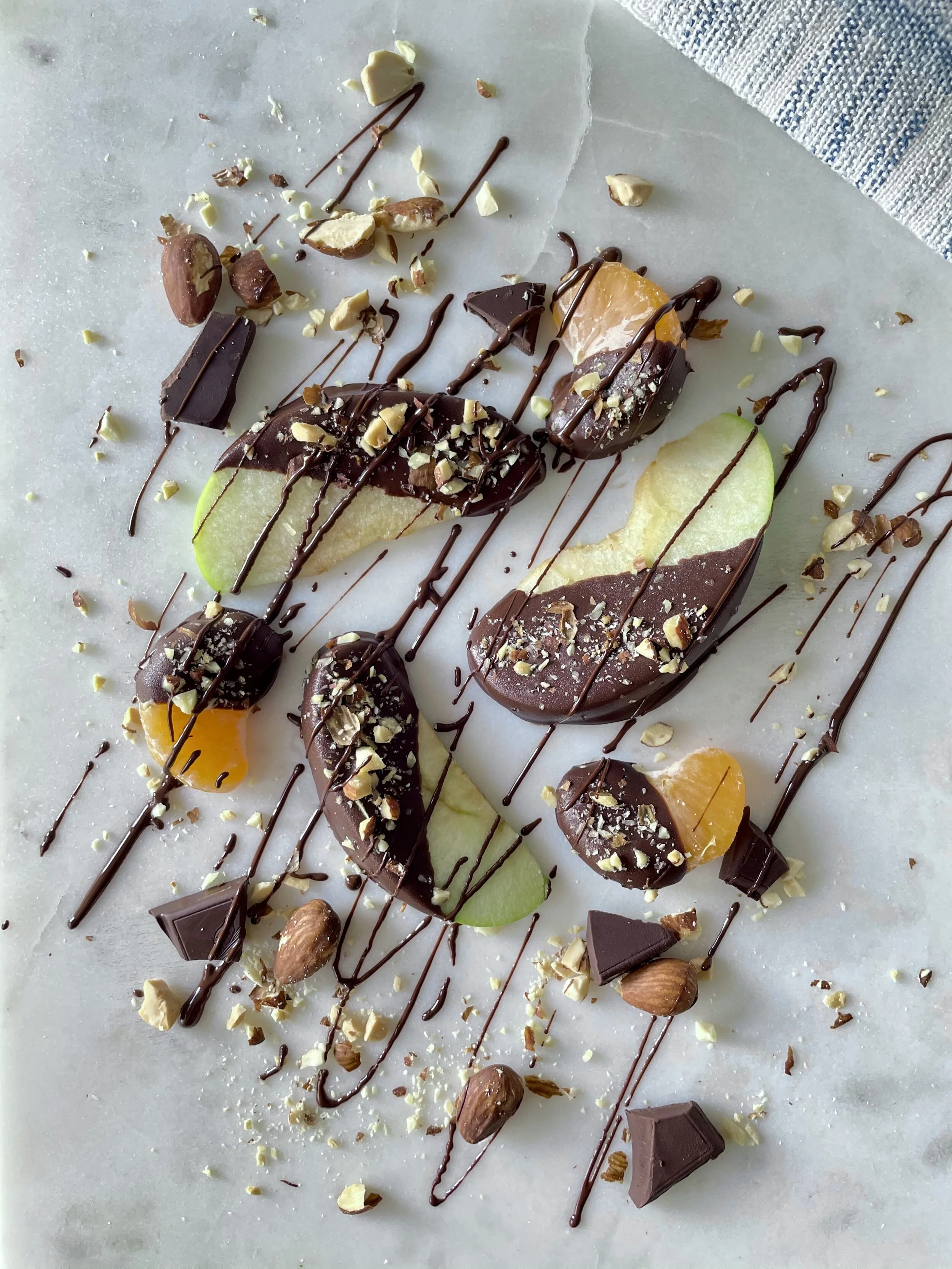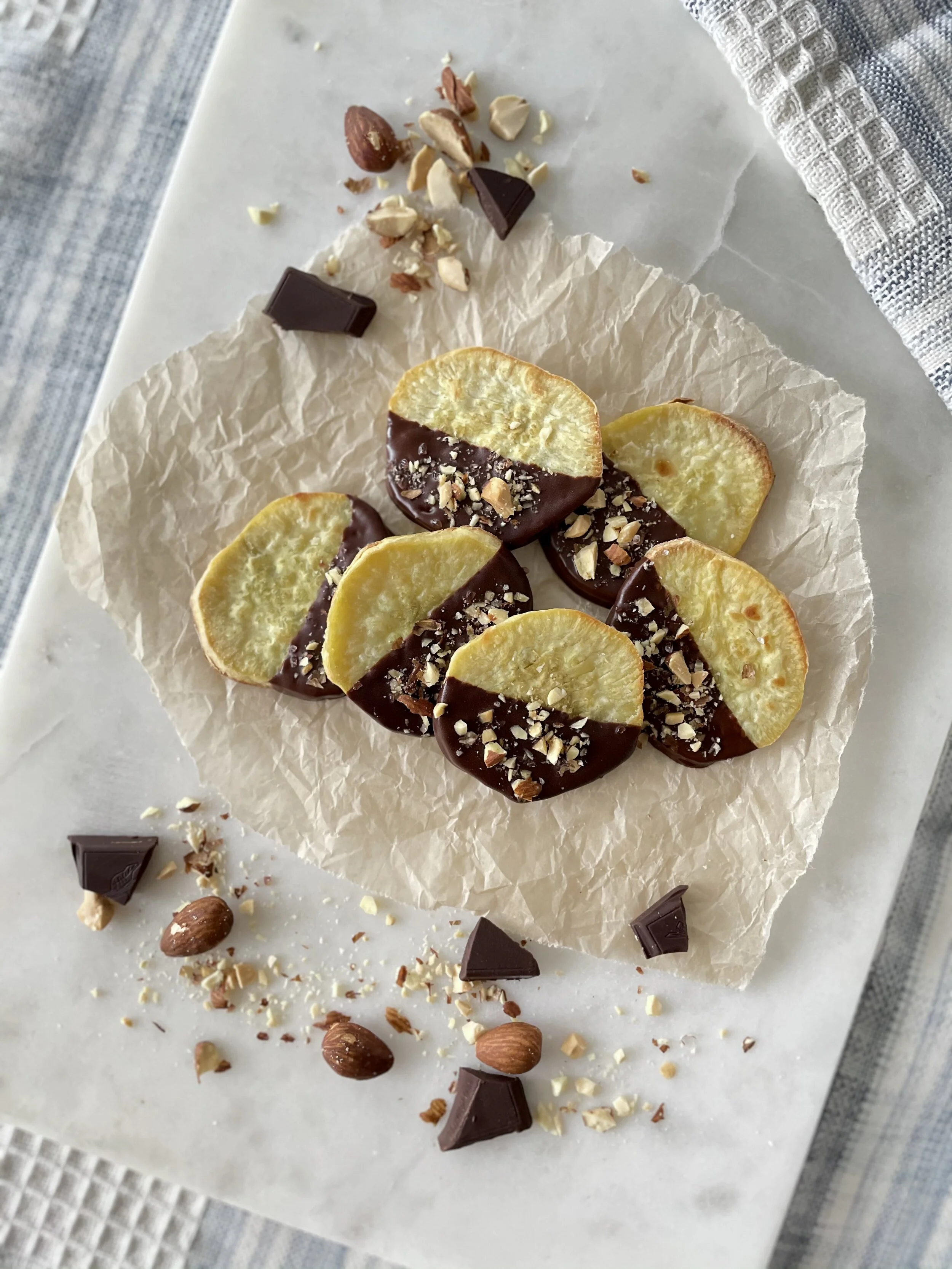Valentine’s day isn’t the only day you can spoil someone (or yourself) with some chocolatey treats! I mean, you don’t need permission to treat yourself with chocolate on any given day, but today is the day, it’s National Chocolate Covered Anything Day! Have you ever wondered what chocolate-covered broccoli would taste like? Us too, but not curious enough to make it. However, we are observing NCCAD by covering yellow Japanese sweet potatoes, also known as satsumaimo, tangerines, and green apples with dark chocolate! Before we share the recipe, let’s talk about the three main chocolate players, the stars of the day.
Overview of the different types of chocolate!
There are various types of chocolate depending on the degree of the refining process that it goes through (1). Some will have more cocoa butter, cocoa solids, sugar, fat, milk, and other additives while some don't contain all of these ingredients. The basis of the chocolate family can be broken down into three types - white chocolate, milk chocolate, and dark chocolate.
When you mix cocoa butter, sugar, milk, vanilla, and lecithin you’ll get the one and only, ivory-colored chocolate. Sugar, milk, and vanilla are the reason why its flavor profile is very sweet, creamy, and like vanilla. It does not have a strong chocolate profile because it does not contain any cocoa solids, so you might be wondering if white chocolate really is chocolate. Well, that depends! According to the U.S. Food and Drug Administration (FDA), a product can be labeled as “white chocolate” if it contains at least 20% cocoa butter (fat made from the cocoa bean), 14% milk solids, and no more than 55% of sweetener (2). White chocolate is probably not the best day-to-day chocolate treat because out of all the chocolates, white chocolate was found to contain the highest amount of sugar followed by milk chocolate (3). This brings us to the next type of chocolate…
Milk chocolate is the best of three worlds. It’s sweet, creamy, mildly chocolatey, and everyone loves it. Unlike white chocolate, milk chocolate contains a mixture of cocoa solids and cocoa butter, known as chocolate liquor. It also contains sugar, milk, and sometimes additives that help to blend the fats with non-fat ingredients to achieve a smooth and creamy texture, like soy lecithin (1). FDA defines milk chocolate as a product containing at least 10% chocolate liquor, 3.39% milkfat, and 12% milk solids (2). Milk chocolate is the middle ground between white and dark chocolate. It’s still sweet, but not that sweet, and it's chocolatey but not bitter making it a perfect treat to give to loved ones.
Dark chocolate is also known as black or semisweet chocolate. It has a deeper brown color, firmer in texture, and it’s less sweet than milk chocolate but it contains more fat than white and milk chocolate. In fact, the higher the percentage of chocolate liquor it contains, the higher the fat content (1,2). Milk and an emulsifier are sometimes added to the mixture to make it more creamy and smooth, but when dairy is omitted, it can be a vegan-friendly option. You can look for dairy ingredients in the ingredients list! According to the FDA, the product must contain at least 15% chocolate liquor, but the products that you usually see on the shelves contain 50% or higher (1).
The Nutrition Profile of Dark Chocolate
Dark chocolate has gained popularity over the years because of the health benefits being published in articles, claiming that it has cardiovascular health benefits. There were studies analyzed showing that higher chocolate consumption was associated with reduced risk of cardiovascular disease (except heart failure), and stroke but these studies do not provide a strong pool of evidence, and more studies need to be done specifically on the effects of dark chocolate (4). Nevertheless, dark chocolate can still be a nutritious treat! It contains nutrients beneficial for our body like polyphenols, calcium, phosphorus, magnesium, copper, zinc, iron, and potassium (4,5).
100 grams of dark chocolate with 70-85% cocoa solids contain (5,6):
Protein: 7.79 g
Fiber: 10.9 g
Calcium: 73 mg (7.3% of AI* for 19-50-year-olds)
Iron: 11.9 mg (148% of RDA** for 18 years and older males, 66% of RDA for 18-50-year-old females)
Magnesium: 228 mg (57% of RDA for 19-30-year-old males, 73% of RDA for 19-30-year-old females)
Phosphorus: 308 mg (44% of RDA for 19 years and older)
Potassium: 719 mg (15% of AI for 14 years and older)
Zinc: 3.31 mg (30% of RDA for 14 years and older males, 41% of RDA for 19 years and older females)
Copper: 1.7 mg
*AI = Adequate Intake: The level of nutrient assumed to ensure national adequacy.
**RDA = Recommended Dietary Allowance: The average daily intake that’s enough to meet the nutrient requirements of 97-98% of healthy people.
Note: DRI’s do not reflect values for pregnant and lactating women.
Even with all of these nutrients, 100 grams of dark chocolate is about 3.5 oz which is way too much to eat in one sitting. Unless you want to add 598 calories and 43 grams of fat to your day, remember to enjoy it in moderation!
What are polyphenols?
Polyphenols are a form of antioxidants, naturally found in many fruits and plant foods, such as apples, pears, cherries, berries, and cacao beans (7). Polyphenols can also be found in products made from sources containing polyphenols, which is why chocolate contains polyphenols. Polyphenols have been studied to examine its health benefits to the human body and many of these studies have indicated that polyphenols can play a vital role in human health regarding cancer and chronic diseases such as diabetes, cardiovascular disease, and obesity due to its antioxidant and anti-inflammatory properties(7,8,9). Regardless of the many studies that were done in the past on polyphenols, there is still a need for further research to better understand its short- and long-term effects, as well as its effects in regards to cases of overconsumption in its supplemental form (9).
Antioxidants are substances that have a protective role in cells, keeping them from receiving damage from radiation and chemicals that are inevitably made while we exercise or when our body turns the food we eat into energy (9). Antioxidants are found in foods such as vegetables and fruits, or supplements, however, studies have still not fully understood the effects of antioxidant supplements in relation to chronic diseases (7,9).
How To Observe National Chocolate Covered Anything Day with Dark Chocolate!
Pairing dark chocolate with sweet potato and fruits can increase the nutritional value of your treat/snack! Sweet potato is packed with vitamin A and contains other beneficial nutrients such as fiber, vitamin C, thiamin, potassium, zinc, calcium, iron, magnesium, and phosphorus (5). Tangerine and apples can also provide more fiber. 1 medium tangerine (88 grams) can provide 1.6 grams of fiber, and 1 medium apple with skin (169 grams) can provide 4 grams of fiber! In addition to fiber, tangerine is packed with vitamin C, has moderate amounts of vitamin A, and contains some other nutrients such as thiamin, vitamin B6, copper, potassium, vitamin B5. Also, apples are packed with potassium and contain other nutrients such as vitamin K, A, folate, phosphorus, magnesium, and calcium (5).
The recipe:
Ingredients:
6 oz dark chocolate (72%)
1 large yellow Japanese sweet potato
1 tangerine, 2 green apples, or your favorite fruit!
1 oz almonds with skin
¼ tsp sea salt or flaky salt
1 to 2 tbsp oil (olive oil or vegetable oil)
Instructions:
Preheat the oven to 375 F.
Roughly chop almonds if you bought them whole.
Prepare the sweet potatoes.
Wash, scrub, rinse and peel the sweet potatoes. Pat potatoes dry with a paper towel.
Cut potatoes about ⅛ inch thick.
In a bowl, toss sliced potatoes with oil until all potato slices are lightly coated in oil.
Place potatoes on a baking sheet lined with parchment paper or foil.
Bake for 25-30 minutes or until potatoes is crispy. Flip each potato once or twice throughout the cooking process to evenly cook each side. Some might take longer or shorter depending on the thickness.
Prepare the fruits.
Peel and segment tangerines.
Wash and cut the apples into wedges, leaving the skin on. The thickness is up to your preference.
Keep fruits in the refrigerator covered with plastic wrap.
Line a baking sheet with parchment paper, wax paper, or foil and set to the side.
Let’s melt the chocolate!
Break the dark chocolate into smaller pieces and pour into a heat resistant bowl.
Heat water (just a few inches of water) in a saucepan over medium heat, and let it simmer. There should be enough water but not too much to touch the bottom of the bowl.
Place the bowl of dark chocolate over the pot of simmering water. Stir continuously until all of the chocolate pieces are melted smoothly. This will take less than 5 minutes.
Once the chocolate has melted, turn off the heat and set the bowl to the side. Wipe the bottom and avoid water from going into the bowl.
Put it all together!
Dip half of the sweet potato chips, tangerine, and apple wedges into the melted chocolate and place them on the lined baking sheet. You can even play around and drizzle the chocolate on top instead of dipping the fruits! Note: if your apples are a bit too moist, pat them dry using paper towels before dipping in chocolate to ensure that the chocolate coating sticks.
Drizzle chopped almonds and a bit of salt on top of the chocolate part.
Store the chocolate-covered pieces in the refrigerator and let the chocolate harden. About 10-15 minutes.
Share and enjoy!



